Great Painting Hacks and Some Urban Sketching
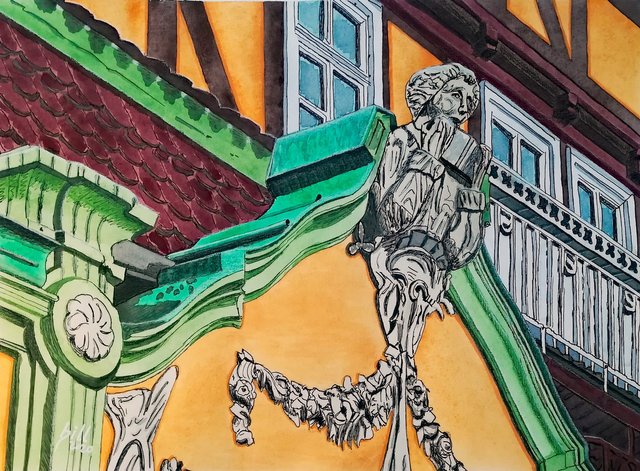
ink and watercolor on paper
40 x 30 cm (15 ¾" x 11 ⅞")
As those of you who actually read my posts know, I have been painting only for roundabout six months now. I had not painted anything since my school days (a long time ago) and used to hold a deep seated belief of having zero talent for art. Long story short, those last six months have been a quite rewarding experience and I'd like to share some of the things I picked up along the way to perhaps motivate you, gentle reader, to give art a try.
Wie diejenigen unter euch, die meine Beiträge tatsächlich lesen, wissen, male ich erst seit etwa sechs Monaten. Ich hatte seit meiner Schulzeit (vor vielen Jahren) nicht mehr gemalt und hatte den festen Glauben, dass ich null Talent für Kunst habe. Lange Rede, kurzer Sinn, diese letzten sechs Monate waren eine echt lohnende Erfahrung, und ich möchte einige der Dinge, die ich aufgeschnappt habe, mit euch teilen, um euch, liebe Leser, vielleicht zu motivieren, es auch mal mit der Kunst zu versuchen.
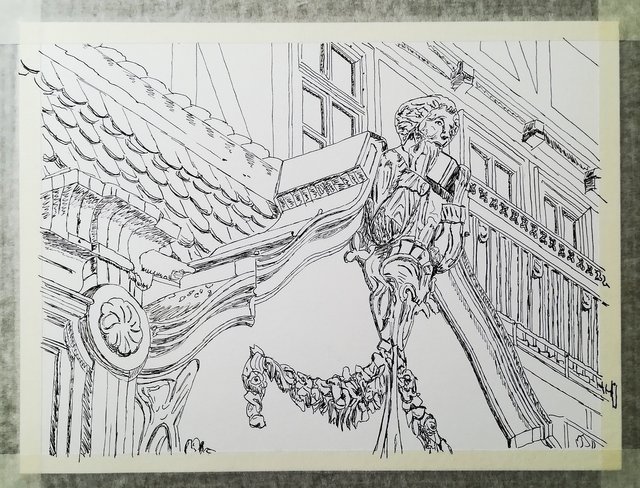
(1) You don't need talent...
...at least not a whole lot of it. Trust me, all my life I couldn't draw more than a stick figure, and those piss poor art classes in school reinforced my belief of being no good at art instead of overcoming it. Now I'm painting pretty much whatever I please! Sure, I'm still not really good at it, and I'm painting from reference photos, but so what? I'm enjoying every relaxing moment of it, I'm learning new skills every day, and I know I will get better if I apply myself.
My takeaway so far is, art is not some mystical gift, but mostly a craft - and any craft can be learned to a very high degree. With luck, you'll discover a special something in yourself that makes you apply the craft in new creative ways, at which point you will rise above mere trained skill and be a "real" artist. But this can never happen unless you get started and put in some time. It might never happen, but oh boy, what an enjoyable journey!
I know, I headlined with "painting hacks", and this first bit is not a hack, but more of a general sermon. I just wanted to share this urgently, in the hope of motivating those of you who have put off trying art on account of the screwed-up mindset I, too, used to have. The remainder of this post will deal with specific items pertinent to watercolor and gouache - cross my heart and hope to die.
(1) Ihr braucht kein Talent...
...zumindest nur ein ganz kleines Bisschen. Glaubt mir, mein ganzes Leben lang konnte ich nicht mehr als Strichmännchen zeichnen, und der beschissene Kunstunterricht in der Schule bestärkte mich schon als Kind in meinem Glauben, künstlerisch unfähig zu sein, anstatt diesen zu überwinden. Jetzt male ich so ziemlich alles, was mir Spass macht! Sicher, ich bin noch lange nicht wirklich gut, und ich male mit Referenzfotos - na und? Ich genieße jeden entspannenden Moment, ich lerne jeden Tag was Neues, und ich weiß, dass ich besser werde, wenn ich nur einfach weitermache.
Ich habe gemerkt, dass Kunst keine mystische Gabe, sondern vor allem ein Handwerk ist - und jedes Handwerk kann in hohem Maße erlernt werden. Mit etwas Glück entdeckt Ihr ein besonderes Etwas in euch selbst, das euch dazu bringt, das Handwerk auf eine neue, kreative Weise anzuwenden, und dann werdet ihr über das erlernte Können hinauswachsen und "echte" Künstler sein. Aber das kann nie passieren, wenn ihr nicht anfangt und etwas Zeit investiert. Vielleicht wird es niemals passieren, aber, Mensch, was für eine tolle Entdeckungsreise!
Ich weiß, ich habe in der Überschrift "Mal-Hacks" angekündigt, und dieser erste Teil ist kein Hack, sondern eher eine allgemeine Gardinenpredigt. Ich wollte das aber dringend loswerden, in der Hoffnung, diejenigen unter euch zu motivieren, die wie ich bloß wegen einer verkorksten Einstellung der Kunst bisher den Rücken zugedreht haben. Der Rest dieses Posts wird sich mit ein paar Tipps befassen, die für Aquarell und Gouache relevant sind - großes Indianerehrenwort.
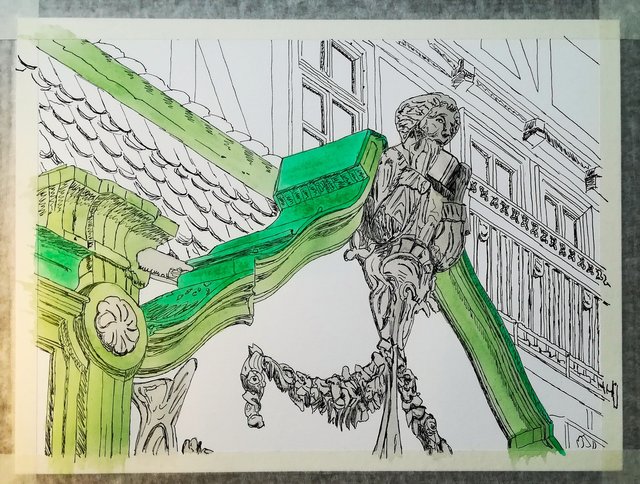
(2) Buying good paper without breaking the bank
Once you get bit by the art bug, you'll spend a lot of time practicing, and you will need lots of paper. Especially with watercolor there's no joy in messing with cheap, poor quality papers, but premium papers like Arches or Fabriano are too expensive for experiments. So we need a compromise.
After much trial and error, I'm now using "Expression" by Hahnemühle. "Expression" is a
- 140 lbs (300 gsm) paper,
- made from 100% cotton,
- cold pressed,
- surface sized,
- acid free, and
- age resistant.
Here in Germany, a 12" x 16" pad of 20 sheets runs about 18.50 EUR ($20.00 USD) which makes it pretty much the least expensive rag paper out there. So check Amazon.com for this paper to see whether it's as good a deal in your country. BTW, Hahnemühle also makes a great paper for acrylics, if that's more your thing.
(2) Gutes Papier kaufen, ohne das Budget zu sprengen
Wenn ihr erst einmal von der Malerei angefixt seid, werdet ihr viel Zeit mit Üben verbringen, und ihr werdet viel Papier brauchen. Vor allem bei Aquarellfarben macht es keinen Spass, sich mit billigen, minderwertigen Papieren herumzuschlagen, aber Premium-Papiere wie Arches oder Fabriano sind viel zu teuer für Experimente. Wir brauchen also einen Kompromiss.
Nach vielen Irrungen und Wirrungen male ich jetzt auf "Expression" von Hahnemühle. "Expression" ist ein Papier mit
- 300 g/m² (140 lbs),
- aus 100% Baumwolle, ist
- matt (cold pressed),
- oberflächengeleimt,
- säurefrei und
- alterungsbeständig.
Ein 20 Blatt großer Block im Format 30 x 40 cm kostet etwa 18,50 EUR und ist damit das günstigste Hadernpapier, das ich finden konnte. Achtung: Boesner führt zwar Hahnemühle-Papiere, aber nicht das "Expression", vermutlich weil es etwa den gleichen Preis wie Boesner's Hausmarke mit nur 25% Hadernanteil hat.
"Expression" gibt es u.a. bei Gerstaecker und etwas billiger bei Kreativ.de (Gerstaecker's Tochterfirma). Übrigens stellt Hahnemühle auch ein großartiges Papier für Acryl her (330 g/m²), wenn das eher euer Ding ist.
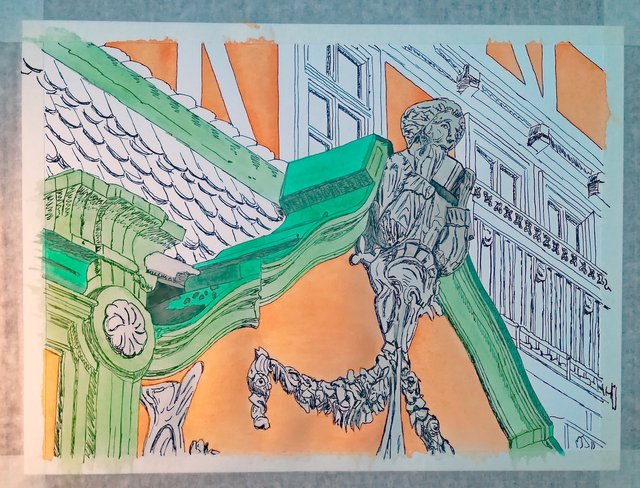
(3) Inexpensive (kinda) watercolor and something extra
Trust me, in general terms, it doesn't make much sense to start painting with cheap watercolor paints, I tried that. They're just not as brilliant, and they also behave differently from the quality stuff. Unfortunately, the name brands - although worth it - cost a pretty penny. Between paper, brushes, and paints, cost can be a tough hurdle for just a try-out. So here is a somewhat unorthodox idea that worked for me:
Consider buying a starter set of high quality watercolor pencils! I have bought "Albrecht Dürer" by Faber Castell, which is a top product, but still less expensive than a basic set of good watercolors and brushes. Alternatively, you can buy "Mondeluz" watercolor pencils by Koh-I-Nor (similar quality, less money) or, slightly higher, "Supracolor Soft" by Caran d'Ache. All three are professional pencils with excellent lightfastness, so you don't have to worry about your art fading.
Why?
Firstly, doodling with those wonderfully soft color pencils is an almost sensual experience in its own right that will make you get deeper into the art experience. A good start!
Secondly, buy an inexpensive water tank brush like the Pentel "Aquash" and create wonderful color blends in your pencil drawing that look almost like a real watercolor. More bang for your buck!
Thirdly - here is where it gets interesting - with a few more inexpensive supplies, you can experience real watercolor painting that is pretty close to painting whith those expensive paints. Read on!
(3) (Fast) spottbillige Aquarellfarben mit Bonuseffekt
Glaubt mir, im Allgemeinen ergibt es nicht viel Sinn, mit billigen Aquarellfarben zu malen; das habe ich versucht. Sie sind einfach nicht so brillant, und sie verhalten sich auch anders als das Qualitätszeug. Leider kosten die Markenfarben wie Schmincke (obwohl sie es wert sind) - einen Batzen Geld. Mit Papier, Pinseln, Farben können die Startkosten eine ziemliche Hürde sein, wenn man "nur mal probieren" will. Hier habe ich einen eher unorthodoxen Vorschlag, der für mich funktioniert hat:
Erwägt den Kauf eines Starter-Sets hochwertiger Aquarellstifte! Ich habe "Albrecht Dürer" von Faber Castell gekauft, ein Spitzenprodukt, aber immer noch günstiger als ein Basis-Set von Aquarellfarben und Pinseln. Alternativ könnt ihr "Mondeluz"-Aquarellstifte von Koh-I-Nor (ähnliche Qualität, weniger Kohle) oder, nach oben, "Supracolor Soft" von Caran d'Ache kaufen. Alle drei sind professionelle Künstlerstifte mit ausgezeichneter Lichtechtheit, so dass ihr euch keine Sorgen machen müsst, dass eure Kunstwerke demnächst verblassen.
Wie jetzt?
Erstens ist das Kritzeln mit diesen wunderbar weichen Farbstiften eine fast schon sinnliche Erfahrung, die euch tiefer in das neue Kunsterlebnis eintauchen lässt. Ein guter Anfang!
Zweitens: Kauft euch einen preiswerten Wassertankpinsel wie den Pentel "Aquash" und vermalt eure Farbstiftzeichnungen damit. Das Ergebnis sieht fast schon wie ein echtes Aquarell aus. Kleine Mittel, große Wirkung!
Drittens - hier wird es interessant - mit ein paar wenigen zusätzlichen Anschaffungen könnt ihr für wenig Geld einer Aquarellmalerei frönen, die fast so gut wie die mit den teuren Farben gelingt. Lest weiter!
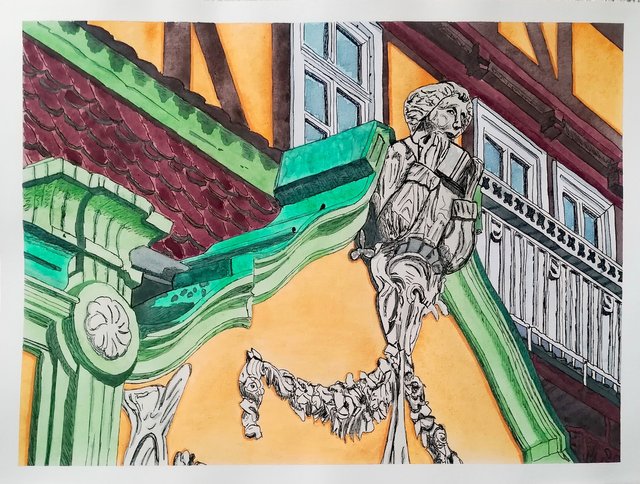
(4) Gum arabic is your friend!
Besides the pigment, gum arabic is the main ingredient in watercolor and gouache. It's the binder that makes the pigment stick to the paper. It is also responsible for the characteristic way in which the paint flows over the paper; it's what lets us push the pigment around.
I suggest you go buy a small quantity, a few ounces, of gum arabic for watercolor. You can get it at art supply stores for a few bucks. I wrote "for watercolor", because this variety contains a preservative preventing mold on your painting - as opposed to the gum arabic sold for nutritional purposes.
While you're at the art store, buy one of those cheap plastic palette trays and get some sandpaper, 100 grit or so. Use the sandpaper to roughen up the plastic palette tray - the rougher, the better. Wash off the plastic dust thoroughly. Finally, make a 100:1 mix of water with gum arabic, i.e. fill a small bottle with 100 ML water and 1 ML of the gum arabic.
And now for the magic:
Put down 3-5 drops of your gum arabic water on the roughed-up portion of the palette. An eye-dropper comes in handy for this. Take one of your watercolor pencils and rub it through this little puddle until you get a nicely saturated paint blob. Then pick up some with a brush and paint!
On proper watercolor paper this mixture will behave exactly like the most expensive watercolor from a tube, and look almost as brilliant. After drying, the only difference will be a very slight haze from the wax of the pencil lead, but this is hardly noticeable and certainly not objectionable. As long as you use top quality watercolor pencils (per hack # 3) you won't have to worry about the lightfastness, either.
Voilà, as promised earlier, you now have very inexpensive, high quality watercolor paints, as many shades as you have pencils, plus a million of easily mixed other colors!
Best of all, everything you bought so far is useful in the long run as you continue your art journey, even after you add more and other supplies. The pencils can be used dry to add accents and details to your watercolor art, a palette is always handy, and the gum arabic works great with gouache, too. All watercolor supplies play well with each other, which is why I love these media so much.
But if it turns out this painting thing isn't for you, you haven't laid out much cash and your kids have a great set of colored pencils for school or play. Oh yeah, the paper is a great card stock, and the gum arabic - slightly diluted - is a good paper-on-paper glue. Coat some paper slips with it and let it dry. You can lick them like stamps and make 'em stick anywhere: gum arabic is non-toxic. Talk about thrifty!
(4) Gummiarabikum ist euer Freund!
Neben dem Pigment ist Gummiarabikum der Hauptbestandteil von Aquarell und Gouache. Es ist das Bindemittel, das das Pigment auf dem Papier haften lässt. Es ist auch für die charakteristische Art und Weise verantwortlich, in der die Farbe über das Papier fließt; es ist das, was uns das Pigment so schön herumschieben lässt.
Ich schlage vor, dass ihr eine kleine Menge, ein paar Milliliter Gummiarabikum für Aquarellfarben kauft. Das kriegt ihr im Kunsthandel, z.B. bei Boesner 100 ml für 7,75 EUR. Ich habe "für Aquarell" geschrieben, weil diese Sorte ein Konservierungsmittel enthält, das Schimmelbildung auf euren Gemälden verhindert - im Gegensatz zu dem Gummiarabikum, das für Ernährungszwecke verkauft wird.
Während ihr im Kunstgeschäft seid, kauft auch eine dieser billigen Plastikpaletten (Boesner, Ars Nova, 35 x 25 cm, 3,65 EUR) und besorgt euch etwas Schleifpapier, etwa 100er-Körnung oder so. Verwendet das Schleifpapier, um die Kunststoffpalette aufzurauen - je rauer, desto besser. Wascht den Plastikstaub gründlich ab. Schließlich stellt ihr eine 100:1-Mischung aus Wasser und Gummiarabikum her, d.h. füllt eine kleine Flasche mit 100 ml Wasser und 1 ml Gummiarabikum.
Und jetzt der Zaubertrick:
Gebt 3-5 Tropfen von eurem Gummiarabikum-Wasser auf die aufgerauten Palette. Eine Pipette ist dazu sehr praktisch. Nehmt einen der Aquarellstifte und reibt ihn durch diese kleine Pfütze, bis ihr einen schön gesättigten Farbklecks bekommt. Dann nehmt etwas davon mit einem Pinsel auf und malt!
Auf Aquarellpapier verhält sich diese Mischung genau wie die teuerste Aquarellfarbe aus der Tube und sieht fast genauso brillant aus. Nach dem Trocknen wird der einzige Unterschied ein ganz leichter Schleier aus dem Wachs der Farbstiftmine sein, der aber kaum wahrnehmbar und sicher nicht zu beanstanden ist. Solange ihr hochwertige Aquarellstifte (siehe Hack Nr. 3) verwendet, braucht ihr euch auch um die Lichtechtheit keine Sorgen zu machen.
Voilà, wie bereits versprochen, habt ihr jetzt sehr preiswerte, qualitativ hochwertige Aquarellfarben, so viele Farbtöne wie Buntstifte, plus eine Million leicht mischbarer anderer Farben!
Und das Beste ist, dass alles, was ihr bisher gekauft habt, auf lange Sicht künstlerisch nützlich ist, auch nachdem ihr mehr und andere Materialien hinzugekauft habt. Die Stifte können trocken verwendet werden, um eurer Aquarellmalerei Akzente und Details hinzuzufügen, eine Palette wird sowieso ständig benötigt, und das Gummiarabikum funktioniert auch hervorragend mit Gouache. Alle diese Materialien sind extrem kompatibel, deshalb gefallen mir diese Wasserfarb-Medien auch so gut.
Aber wenn sich doch herausstellen sollte, dass diese Malerei-Geschichte nichts für euch ist, habt ihr nicht viel Geld ausgegeben und die Kinder haben einen tollen Satz Farbstifte für die Schule oder zum Spielen. Ach ja, das Papier ist ein schöner Bastelkarton, und das Gummiarabikum - leicht verdünnt - ist ein guter Papier-auf-Papier-Kleber. Streicht ein paar Zettel damit ein und lasst sie trocknen. Ihr könnt sie dann wie Briefmarken abschleckern und überall hinpappen; Gummiarabikum ist nämlich ungiftig. Sparsam wie die schwäbische Hausfrau!

Alrighty, that's it for today. Next time, I'll explain how to fill a regular fountain pen with india ink, which is what I used for the urban sketching illustrating this article. You're cordially invited to blow as much voting mana on this post as you possibly can. Any upvoter over 100% wins a Volkswagen Diesel and a gas mask.
Thanks for looking, and please don't forget to upvote and resteem if you liked my art. Until next time!
Also gut, das soll's für heute gewesen sein. Das nächste Mal erkläre ich, wie man einen gewöhnlichen Füllfederhalter mit Tusche betreibt, was das Zeichengerät für den Urban Sketch in diesem Artikel war. Jetzt seid Ihr herzlich eingeladen, soviel Voting Mana wie möglich an diesen Post zu verballern. Jeder, der mehr als 100% upvotet, gewinnt einen VW Diesel und eine Gasmaske.
Danke fürs Anschauen, und vergesst bitte nicht das Upvoten und Resteemen, wenn euch mein Beitrag gefallen hat. Bis zum nächsten Mal!
Dear Folker you are a show! I can invite you to take a lesson to my students (with gas masks of course) I hope to win a Wolkswagen not diesel but electric or at most natural gas.
Thanks for this beautiful post and I will share it immediately. Mythical!
A big hug to you and your lady.
...at least not a whole lot of it. Trust me, all my life I couldn't draw more than a stick figure, and those piss poor art classes in school reinforced my belief of being no good at art instead of overcoming it. Now I'm painting pretty much whatever I please! Sure, I'm still not really good at it, and I'm painting from reference photos, but so what? I'm enjoying every relaxing moment of it, I'm learning new skills every day, and I know I will get better if I apply myself.
LOVE IT
Thank you so much for your remarks! So glad you enjoyed this post. I don't understand how I overlooked this for 3 days, but I did. Sorry.
I blame it on la padrona di casa who near sold out at the bazaar, made a ton of money, and grew at least 10 cm, I swear. All the while, I'm busy trying to remove these sales from her web store, with a slow Internet on what is essentially American soil.
Even I sold two paintings (more Schmincke for me this week, ha!) and I guess I'm a "real artist" now. So funny, yesterday, I didn't know how to spell "painter", and today I am one ;-)
Anyway, in your photos, I have seen the eyes of YOUR students, and how you managed to get them thinking about their art. I wish YOU had been my art teacher back in the day; I wouldn't have missed out for so long.
Grazieeeeeeee
Beautiful colors behind you - make a post of it. Does the cat take hugs, too? She's pretty!
look here https://beta.steemit.com/oc/@armandosodano/my-night-friend-watercolor-step-by-step-il-mio-amico-notturno-acquarello
Thank you, I enjoyed that post. "King of the neighborhood" indeed! So many great posts in Steem's past. This is one of them.
Prego signore. La volkswagen sta arrivando.
The Steem blockchain is currently being attacked by a central authority in order to take control of the witnesses. If you are not managing your witness votes, please consider setting @berniesanders as your witness voting proxy by clicking here to help restore the decentralization of Steem.